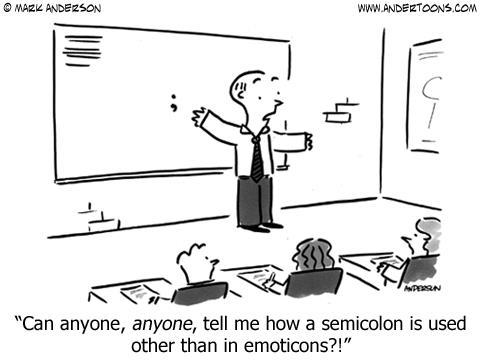
This gem was sent in by a follower on Facebook.
The Semicolon
A semicolon is a punctuation mark used to connect two thoughts or ideas which are somehow similar. Generally, each thought or idea could be used as its own sentence, but the flow of the work may be interrupted by the short, choppy sentences.
Semicolons are a little archaic and are not necessary in modern writing. Even in formal writing, they may be replaced by a comma or a period. However, if they are used properly, semicolons can add a pleasing continuity to your work.
When reading out loud, we pause for semicolons much the same way we pause for a comma.
Semicolons work like a soft period, separating the thoughts but keeping the flow of the first sentence.
I’m looking for my book; where do you suppose I put it?
Money is the root of all evil; I don’t believe the reverse is necessarily true.
Martha has gone to the library; Andrew has gone to play soccer.
Journalism has changed over the last hundred years; possibly, this change is for the better.
In creative writing, you can use a semicolon to connect multiple ideas which are expressed in independent clauses. The effect is very poetic: be sure you don’t use this in formal writing.
The woman was heartbreakingly beautiful; she was dark and stormy; she was utterly dangerous.
Semicolons can also be used to separate short clauses in a list after a colon has been used. This is done to clarify the ideas for the reader so they don’t get confused; this practice is particularly useful if the clauses have commas or other punctuation in them.
Please do the following assignments for homework: read pages 15-17 and 20-33 in your math text; finish the outline for your Canada: A Short History essay; finish readingThe Giver, but don’t start writing the essay yet.
I need the weather statistics for the following cities: London, England; London, Ontario; Paris, France; Paris, Ontario; Perth, Scotland; Perth, Ontario.
A semicolon should only be followed by a capital letter if the word is a proper noun or an acronym.
We can go to the museum to do some research; Mondays are pretty quiet there.
Let’s go to Europe; Paris is nice in the spring.
